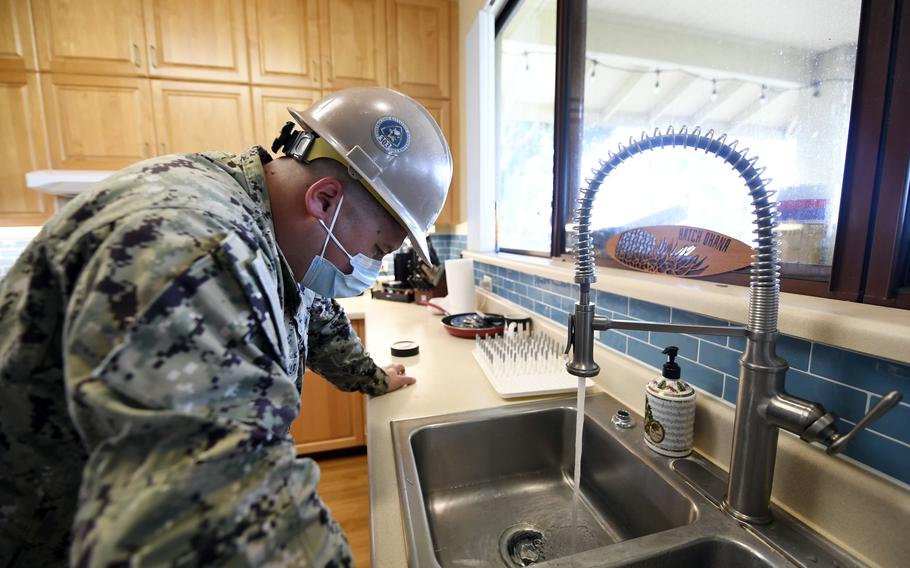
A sailor inspects running water at a home on Joint Base Pearl Harbor-Hickam, Hawaii, on Feb. 18, 2022, in response to a jet fuel spill that contaminated the area’s drinking water. (Christopher Thomas/U.S. Navy)
The Honolulu Board of Water Supply is still trying to find new water sources to make up for the capacity it lost after the 2021 Red Hill water crisis prompted it to take its Halawa shaft and two smaller wells offline to ensure jet fuel didn't make its way into the public drinking water system.
The reduction in water supply prompted pleas for residents and businesses across Oahu to voluntarily conserve water as the summer months approached in order to avoid mandatory water conservation requirements.
The BWS, which supplies drinking water to most of Oahu, had hoped that six sites it has been exploring would be suitable for well development, but BWS Manager and Chief Engineer Ernie Lau told the " livestream program Monday that four of the locations now appear unsuitable due to site constraints, drainage issues or other problems.
Lau said the BWS is continuing the search, looking at locations that are farther uphill, meaning the wells would need to be deeper.
The search for new water sources began soon after jet fuel leaked from the Navy's Red Hill facility in November 2021, polluting the aquifer that sits just 100 feet below the underground tanks.
The fuel contaminated the Navy's Joint Base Pearl Harbor-Hickam drinking water system, sickening military families. The BWS, which has drinking water wells in the vicinity, shut down its Halawa shaft, which is about a mile from Red Hill, on Dec. 3, 2021, to make sure the contamination didn't migrate into its water distribution system.
This resulted in a 20 % reduction in the water supply for metropolitan Honolulu. Days later it shut down two smaller wells, Aiea well and Halawa well, as an additional precaution.
All three wells remain offline a year and a half later as BWS and state health officials try to better understand whether fuel from the 2021 leak, as well as decades of past leaks from the facility, poses a threat to the nearby county wells.
The BWS is looking to drill more monitoring wells in the vicinity to gauge whether petroleum chemicals are migrating in the direction of the Halawa shaft.
"If we find contamination and there is evidence it is migrating westward across the valley from Red Hill, then I think the decision on a permanent shutdown may be an order, " said Lau.
Lau said the BWS is also conducting a water treatment study to see whether petroleum chemicals, as well as PFAS, chemicals that the Navy has used in its fire suppressant at Red Hill, can be cleaned from the water at the Halawa shaft in the event the water does show contamination.
Concerns about PFAS have increased recently after the Navy reported a 1, 300-gallon leak of the concentrated fire suppressant, called aqueous film-forming foam, at Red Hill in November and two other AFFF spills at Red Hill in recent years have come to light.
The BWS has pegged the cost of new monitoring wells and the development of new wells to replace the lost drinking water capacity at $10 million. The state Legislature is poised to fund half of that. The BWS will have to cover the other half.
The BWS has estimated that it takes about five to seven years to develop a new drinking water well. Lau said that process is now looking more like seven years.
For now he said that Oahu appears to be in a good position as it heads into the summer months, a time when water use spikes amid drier conditions. He said April's water use was well below the five-year average.
If water use gets too high, the BWS will have to move toward mandatory conservation requirements, which can entail restrictions on outdoor irrigation and car washing, among other requirements. Lau said the public would be given adequate warning and that the Water Board would hold a public hearing.
"That is not something that is going to happen overnight, " he said, noting that the advance warning would give residents time to reduce their water use in order to avoid mandatory requirements.
BWS also continues to work toward completing a small water desalination project, which currently could be completed in two to three years. BWS will need to make sure that when the desalinated water is put in its system, it doesn't create water-quality issues when it mixes with the mineral-rich groundwater.
(c)2023 The Honolulu Star-Advertiser
Visit The Honolulu Star-Advertiser
Distributed by Tribune Content Agency, LLC.